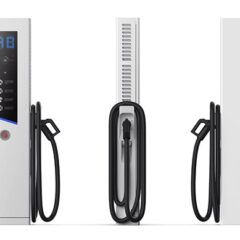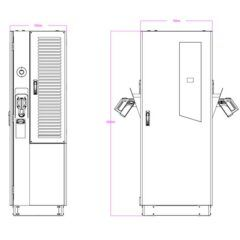Everything you Need to Know about Home Car Charging Station
For charging at home, a high-performance socket mounts on home car charging station. This socket offers you the maximum possible charging power, up to a maximum of 11 kW *. If you charge your electric car via the KW-PEVC3, you just have to plug the charging cable into the socket of your car – and the car starts charging.
Variable based on the charging power available in the home.
Plug in and charge home car charging station
No less comfortable is the charging process at the home car charging station. These are probably made available to you by your employer. In fact, in the parking areas of companies, a charging cable often installs.

If no fixed cable installs in one of the public charging stations, simply use the supplied charging cable. You must always have with you in the luggage compartment.
- An electric car charging via a KW-PEVC3 at home.
- There are two different types of charging
AC Charging (Alternating Current)
Basically, two charging modes distinguish: with AC charging, the car’s internal transformer converts the alternating current supplied by the public network into direct current, that is what the electric motor needs on home car charging station.
DC charging (direct current)
With the second mode, DC charging, the alternating current converts into direct current outside the vehicle – for example in the charging stations. The advantage, in this case, is that recharging can take place at higher powers and the charging processes are automatically faster.
There are two types of connectors
Plug in, recharge, unlock and pull out the plug. Charging your electric car couldn’t be simpler. Over the last few years in Europe, two different types of charging plugs have established themselves as standard:
Spine Mennekes
The “Mennekes plug” (type 2) corresponds to the European standard for AC charging. Most public home car charging station comes with at least one type 2 socket.
AC charging for MEB with powers up to 7 or 11 kW
If you have home car charging station, you can then make a full charge every night with 11 kW. You could also recharge the car in order to be able to cover the weekly needs for traveling from home to the office and vice versa
Combo plug 2
As far as fast charging concerns, the established standard in Europe is the CCS (Combined Charging System). Its plug has additional contacts for fast DC charging. With this type of plug called “Combo2” you can recharge in all public charging stations starting from a power of 22 kW.
From the socket to the fast charging station: recharging the battery is a very quick operation
A simple rule says about home car charging station
The higher the charging power, the faster the charging process. However, the duration can vary greatly, depending on the state of charge of the battery.
During the charging process, environmental conditions such as the outside temperature or that of the vehicle battery are also important. For example if you charge your ID.3 with a domestic socket, you can easily cover your daily needs with 2.3 kW per hour at night. Faster is the home car charging station, less the time consumption will be.
The maximum charging speed achieves with High Performance Charging (HPC) charging stations. These operate with charging powers from 100 kW. In general, it is not advisable to recharge your electric car from scratch every day, but to continuously top up the energy, in order to prolong the life of the battery.
Charging stations for tenants: what to consider

Those who buy an electric car have an advantage if they have a private charging station. What about condominium properties and apartments for rent? We show you the possibilities that there are too easily recharge at home.
In China, electro mobility is advancing
At the end of 2020, the share of fully or partially electric cars stood at 27.9%. And the potential is far from being exhausted. According to a study commissioned by the TCS, 53% of people believe that in the future they will drive an electric car.
But buying home car charging station isn’t everything. Any electric car is easy to recharge from the household power outlet, it takes a very long time for the battery to be charged. By way of comparison: home electrical outlets are safe at 13 amps, but an e-car can draw up to 32 amps.
Additionally, household power outlets do not design to remain permanently charged, which could lead to overloads and, in the worst case, fires. Consequently, anyone interested in buying an electric car can hardly avoid installing a special charging device, also called a “KW-PEVC3”.
Home charging station
A KW-PEVC3 allows you to recharge at maximum speed and is a comfortable and safe solution. It can be separable with the aid of a CEE plug or permanently connected to the alternating current network. But be careful: the installation must absolutely entrust to a specialist.
First, however, an application for a technical connection must be submitted and the installation must be notified to the electricity supplier. No problem for those who own their own home, but for condominiums and tenants it becomes a bit more complicated.
The former must obtain the consent of the condominium assembly, while the latter need the permission of the landlord.
Top up home car charging station for tenants
A landlord is free to decide whether to accept the request to install an electric charging station. The simplest thing is for the tenant to pay all the installation costs. Alternatively, the landlord can take on the cost of the installation and then make up for the investment with the rent.
The first solution is especially useful if the charging device is famous among only one housing unit. But as soon as a second or third station has to install, it is worth investing in a centralized system.
Intelligent electrical distribution
On average, 60% of existing domestic connections are good to use. If you add an electric charging station, you will reach around 90%, especially if you want to recharge quickly.
Invest in the future
In fact, it is not necessary to connect a separate line that includes a safety valve and meter for each recharging unit, but it is possible to access all the existing recharging stations simultaneously.
It is also convenient for rental properties.
Simple and fair billing
Another advantage of a centralized system: instead of the individual meters, the centralized system calculates the distribution of costs based on the use of each.
Real estate owners and condominium administrators would therefore do well to examine the options available: after all, electro mobility is now much more than just an alternative.

